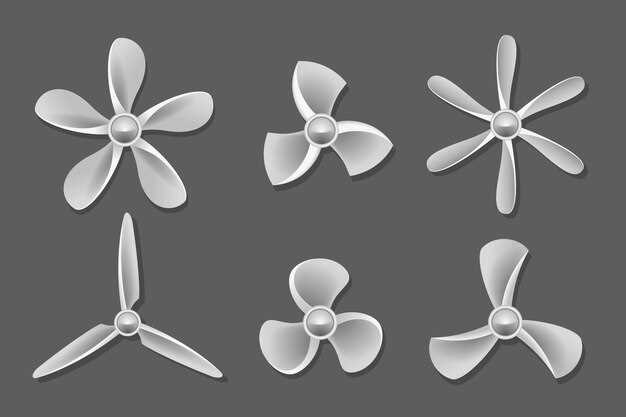Propeller types and how they affect performance

Choosing the right propeller is crucial for maximizing the speed and efficiency of your boat. Different propeller types can significantly influence how well a vessel performs under various conditions. Understanding these distinctions is essential for boaters looking to optimize their craft’s capabilities on the water.
Propellers are categorized based on their design and pitch, which directly affects the boat’s propulsion and maneuverability. Each type offers unique advantages that can enhance performance in different scenarios, whether you prioritize top speed, fuel efficiency, or towing capacity. By exploring the various options available, boat owners can make informed decisions to tailor their vessels for specific activities like recreational cruising or competitive racing.
This article delves into the nuances of various propeller types, analyzing their performance characteristics and helping you recognize the impact of each choice on your boat’s speed. With the right knowledge, you can customize your setup to achieve the best possible results on the water.
Choosing the Right Propeller Type for Your Boat’s Speed Requirements

When selecting a propeller for your boat, understanding the relationship between propeller type and speed is crucial. Different types of propellers are designed to optimize performance based on various factors, including the type of vessel, its intended use, and desired speed.
Two-Blade vs. Three-Blade Propellers: Two-blade propellers are generally lighter and allow for higher speeds, making them suitable for racing vessels or performance boats. However, they can sacrifice stability and thrust at lower speeds. In contrast, three-blade propellers provide better grip and control, making them ideal for heavier boats that require more thrust to achieve optimal speed.
Diameter and Pitch Considerations: The diameter and pitch of a propeller greatly influence its speed capabilities. A larger diameter can produce more thrust, beneficial for acceleration and load-carrying ability. Pitch refers to the distance a propeller would move in one complete revolution. A higher pitch often correlates with increased speed but may require more power, while lower pitch allows for better acceleration.
Material Impacts: The material of the propeller can also affect speed. Aluminum propellers are lighter and can enhance speed, but they may not be as durable as stainless steel options. Stainless steel propellers offer higher performance and durability, suitable for high-speed applications, but they come at a higher cost.
Choosing the right propeller involves balancing these factors to meet your speed requirements effectively. Assessing your specific boating needs and consulting with experts can help you select the optimal propeller type for achieving your desired performance on the water.
How Pitch and Diameter Affect Boat Performance and Fuel Economy

The performance of a boat is significantly influenced by the specific characteristics of its propeller, particularly its pitch and diameter. Understanding these elements is crucial for achieving optimal speed and fuel efficiency.
Pitch refers to the distance a propeller would theoretically move through the water in one complete revolution, assuming no slippage. A higher pitch propeller can increase a boat’s speed because it moves the vessel forward more with each rotation. However, if the pitch is too high for the engine’s power band, it can lead to inadequate acceleration and potential strain on the motor.
Conversely, a lower pitch helps improve acceleration and is typically more efficient at lower speeds. Boats designed for activities such as towing or maneuvering at low speeds benefit from lower pitch propellers, as they allow for better control and responsiveness. It is essential to match the pitch to the boat’s intended use to optimize performance.
Diameter, on the other hand, correlates to the overall size of the propeller. A larger diameter increases the propeller’s surface area, allowing it to grip the water more effectively and generate greater thrust. This can enhance speed, particularly in heavier vessels, as larger propellers can move more water, leading to improved lift and stability.
However, larger diameters may also increase drag, which can negatively impact fuel economy. For boats that prioritize speed, a smaller diameter may be preferable, as it reduces resistance and facilitates quicker hull movements through the water.
Balancing pitch and diameter is essential for maximizing a boat’s performance and fuel efficiency. An ideal combination allows for smooth transitions between speeds while maintaining optimal power usage. Boat owners should assess their specific performance needs and consult with professionals to find the most suitable propeller configuration.
In conclusion, understanding how pitch and diameter impact boat speed and fuel economy is vital for making informed decisions about propulsion systems. By carefully selecting these parameters, boaters can enhance both the efficiency and performance of their vessels on the water.
Evaluating Propeller Materials: Impact on Durability and Handling
When selecting a propeller for a boat, the material it is made from plays a critical role in its performance, durability, and handling characteristics. Understanding the differences between materials can help boat owners make informed decisions based on their specific needs and conditions.
The most common materials used for boat propellers include:
- Aluminum: Lightweight and cost-effective, aluminum propellers are popular among recreational boaters. They provide good performance in calm water conditions but may not withstand heavy impacts or abrasive environments.
- Stainless Steel: Known for superior strength and resistance to corrosion, stainless steel propellers offer enhanced durability and better handling. They are ideal for high-performance boats but come at a higher price point.
- Composite: This material is a blend of plastic and other substances, making composite propellers lightweight and resistant to corrosion. While they are less durable than metal options, they can be effective for smaller boats or in saltwater environments.
- Bronze: Traditional and often used in commercial applications, bronze propellers are highly durable and provide excellent performance in various conditions. However, they may require more maintenance due to potential corrosion over time.
Evaluating the impact of these materials on durability and handling involves considering several factors:
- Resistance to Corrosion: Boats operating in saltwater environments need propellers that can resist corrosion. Stainless steel and composite materials typically outperform aluminum in this regard.
- Damage Tolerance: Aluminum propellers can bend or break upon impact, while stainless steel and bronze offer significant resistance to deformation. This factor is crucial for boaters navigating rocky or hazardous waters.
- Performance Efficiency: The material affects how efficiently a propeller cuts through the water. Stainless steel often provides better performance, especially at high speeds, compared to aluminum and composite options.
- Weight Considerations: Lightweight materials such as aluminum and composites can improve acceleration and handling but may sacrifice durability. Heavier materials like stainless steel and bronze provide stability but can slow down performance.
In summary, the choice of propeller material significantly influences the boat’s handling capabilities and overall durability. Boat owners should assess their specific operational conditions, performance needs, and budget constraints when evaluating propeller materials.




